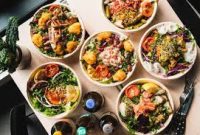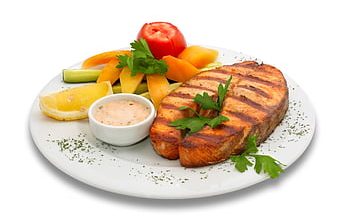In order to maintain a balanced diet and provide your body the nutrition and energy it requires to go through the day, a nutritious lunch is a crucial component. Here are some suggestions for wholesome lunch options and meals:
Salad: Make a filling salad with leafy greens, colorful vegetables, lean protein (chicken, turkey, tofu, chickpeas), and a healthy dressing, such as olive oil and vinegar or a yogurt-based dressing.
A whole-grain wrap is topped with grilled chicken, mixed greens, tomatoes, cucumbers, and a light dressing. Avocado slices can be added for good fats.
Quinoa Bowl: To make a quinoa bowl, combine cooked quinoa with roasted vegetables, tofu or shrimp that has been grilled, and a tasty dressing or sauce. Add nuts or seeds for crunch on top.
Stir-Fry: Make a stir-fry with low-sodium stir-fry sauce, a variety of colorful veggies, and lean protein (chicken, tofu, or shrimp). Serve over cauliflower rice or brown rice.
Make a homemade vegetable soup or soup with broth and additional protein like beans, lentils, or chicken. Serve it with whole-wheat bread or a side salad.
Greek yogurt parfait: For a filling and healthy meal, layer Greek yogurt with fresh fruit, honey, and oats.
Sweet Potato and Black Bean Salad: For a tasty and filling salad, combine roasted sweet potatoes, black beans, corn, red onion, and cilantro with a lime vinaigrette.
Sushi Bowl: Create a sushi bowl by combining cooked sushi rice, chopped raw fish or tofu, sliced avocado, cucumber, and seaweed strips. This will break down sushi into its component parts. Add a soy sauce and sesame seed glaze.
Spread hummus over a whole-grain wrap and top with sliced cucumbers, bell peppers, spinach, and carrot shreds. For a quick and wholesome meal, roll it up.
Egg Salad: Boil some eggs and combine them with Greek yogurt, Dijon mustard, celery, and chives to make a healthier egg salad. Serve on lettuce leaves or whole-grain bread.
Mediterranean Plate: Put together a lunch that is inspired by the region of the Mediterranean Sea by include grilled chicken or falafel, tabbouleh, hummus, olives, and whole-grain pita bread.
Salmon that has been baked, along with a side of steamed veggies, quinoa, or brown rice, is a filling lunch.
Pasta Salad: Make a pasta salad using whole-grain pasta, feta cheese, cherry tomatoes, cucumbers, black olives, and a mild vinaigrette dressing.
Black beans, sautéed bell peppers, onions, and your choice of salsa or guacamole are rolled up within a whole-wheat tortilla.
Repurpose wholesome dinner leftovers into a filling lunch. A simple and practical choice would be leftover grilled chicken, roasted vegetables, or a homemade stir-fry.
To stay hydrated, remember to drink on water or herbal tea throughout the day. In order to avoid overeating during lunch, quantity control is also crucial. Make lunches that suit your dietary preferences and nutrient requirements, and think about getting individualized healthy eating advice from a qualified dietitian.

Benefits:
Numerous advantages for your general wellbeing, energy levels, and productivity come from eating a healthy lunch. Here are a few of the major benefits of including a healthy lunch in your daily routine:
Sustained Energy: Your body receives a consistent supply of energy from a balanced meal, allowing you to remain awake and focused all afternoon. Your productivity at work or school may increase as a result.
Improved Concentration: A nutrient-rich lunch helps boost cognitive function and concentration, giving you the clarity of thought and decision-making you need.
Better Mood: Eating healthfully during lunch can improve your mood. By stabilizing blood sugar levels, it lessens irritation and mood swings.
Weight management: Eating a nutritious lunch might help curb cravings and stop you from overindulging later in the day. It helps with portion control and total calorie management, both of which are crucial for weight loss or weight maintenance.
Lunch provides an opportunity to nourish your body with essential vitamins, minerals, and nutrients crucial for optimal health. These nutrients can be obtained from a variety of sources, including fruits, vegetables, lean protein sources, and whole grains.
Digestive Health: By reducing constipation and fostering good gut bacteria, a balanced meal that includes fiber-rich foods can enhance digestive health.
Blood Sugar Control: Making meal selections that have a low glycemic index can help control blood sugar levels, which is crucial for people with diabetes or those who are at risk of getting the disease.
Heart Health: Vegetables, lean meats, and whole grains are all heart-healthy diets that can help lower cholesterol and lower risk factors for heart disease.
Improved Immunity: A healthy immune system helps your body fight off illnesses and infections. Good diet supports a healthy immune system.
Healthy Habits: Making it a habit to have a healthy lunch will promote overall healthy eating patterns and make it simpler to repress the need to consume unhealthy foods later in the day.
Reduced Cravings: A balanced lunch might help you make healthier food choices by lowering your desire for sugary or high-fat snacks in between meals.
Long-Term Health: Eating balanced, healthy meals regularly can help to improve long-term health outcomes and lower the chance of developing chronic diseases.
Control over Ingredients: Making your own lunch provides you control over the ingredients and serving sizes, enabling you to choose healthier options and stay away from excess sodium and additives that are frequently present in meals from restaurants or takeout.
Savings: Making your own nutritious lunch can cost less than routinely purchasing lunch at cafés or restaurants.
Make lunches that suit your dietary requirements and interests, and think about speaking with a qualified dietitian for individualized advice on good eating practices.



